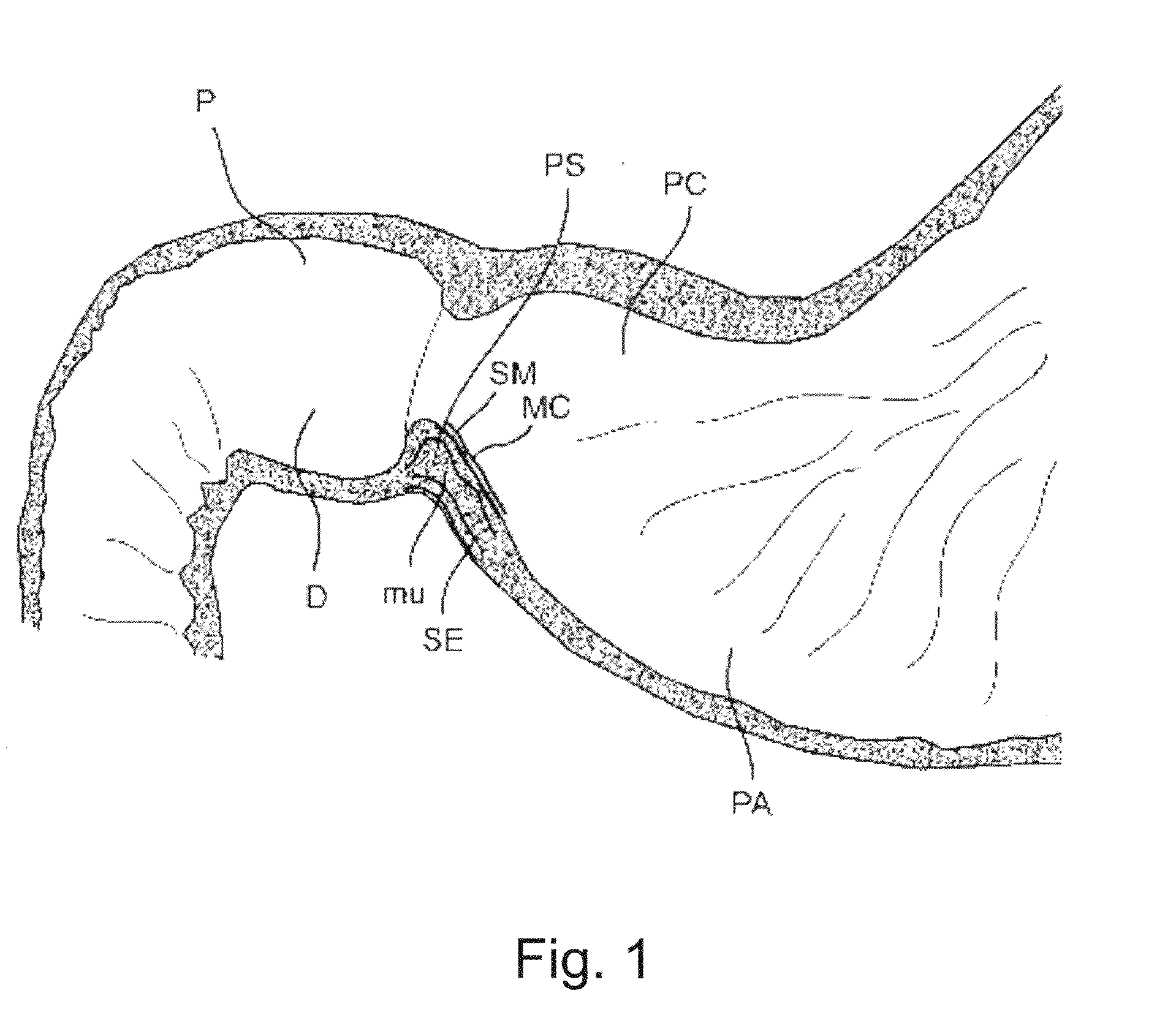Devices and methods for altering eating behavior
a technology of eating behavior and devices, applied in the field of devices and methods for altering eating behavior, can solve the problems of limiting food intake, substantial weight loss, and carries a risk of morbidity, and achieve the effect of effective altering the eating behavior of a subj
- Summary
- Abstract
- Description
- Claims
- Application Information
AI Technical Summary
Benefits of technology
Problems solved by technology
Method used
Image
Examples
example 1
Anchoring of a Pylorus-Attached Device
[0199]Device 100 can be inserted into the pylorus using a variety of techniques. For example, with reference to FIG. 7a, device 100 as depicted in FIG. 5b can be delivered at the end of an endoscope in a tube 120 with an open bottom 122 wherein the body 102 of device 100 is loaded against spring 124 that naturally concaves downwards but is held concave upwards by pin 128 running in a constrained channel through tube 120 and through retaining loops 126. Tube 120 (with anchors 108 retracted in tube 120 so that they cannot damage surrounding tissue) is positioned in the narrow apex of the pylorus P and pin 128 is pulled to release retaining loops 126 which in turn releases body 102 and spring 124 to the concave downward position, wherein anchors 108 are forced to bite into the pylorus tissue and anchor device 100 in the pylorus P (FIG. 7b). Tube 120 is retracted leaving device 10 anchored and positioned in the pylorus (FIG. 7c). The same technique ...
example 2
Implantation of the Present Device in Pigs
[0202]Four female pigs marked Shosh 7 to Shosh 10, approximately 3-4 months old weighing between 60-70 kilograms were selected for the implantation of 4 different configurations of the device of the present invention made of silicone. FIGS. 10a-d illustrate the four configurations of the present device as implanted in the four pigs. Each device shown in the figures was anchored to antrum tissue of a pig to achieve the anchoring positioning shown therein. Thus, FIG. 10a, depicts implantation in a first pig (designated as Shosh 7 in this study) of a 40 mm long 1 cm diameter cylindrical device body which was anchored in the antrum with an anchoring position and tether having a length enabling movement of the device body into the duodenum. FIG. 10b represents similar positioning in a second pig (designated as Shosh 8 in this study) of a device body which includes a plurality of brush-like projections with an anchoring position and tether having ...
example 3
Implantation of a Through-Stomach Antrum-Anchored Gastric Device in Live Pigs
[0215]An eating behavior modification device with a silicone tether and a polypropylene T-anchor was anchored in an antral wall region of stomachs of female pigs using a dual-channel gastroscope. The delivery apparatus and attached device are shown in FIGS. 14-15. As is shown in FIG. 15, the device is secured to the applicator head of the delivery apparatus and the anchoring element of the device is secured within a groove formed in the delivery needle. The needle is disposed within working channel 1 of the gastroscope while the tether is secured against the applicator head by a snare-like element (retaining loop wire) which is disposed within working channel 2.
[0216]To deliver the device, the delivery apparatus and loaded device were guided through the mouth of an anesthetized pig through the esophagus and into the stomach.
[0217]Once the applicator apparatus and loaded device are positioned within the stom...
PUM
 Login to View More
Login to View More Abstract
Description
Claims
Application Information
 Login to View More
Login to View More - R&D
- Intellectual Property
- Life Sciences
- Materials
- Tech Scout
- Unparalleled Data Quality
- Higher Quality Content
- 60% Fewer Hallucinations
Browse by: Latest US Patents, China's latest patents, Technical Efficacy Thesaurus, Application Domain, Technology Topic, Popular Technical Reports.
© 2025 PatSnap. All rights reserved.Legal|Privacy policy|Modern Slavery Act Transparency Statement|Sitemap|About US| Contact US: help@patsnap.com



